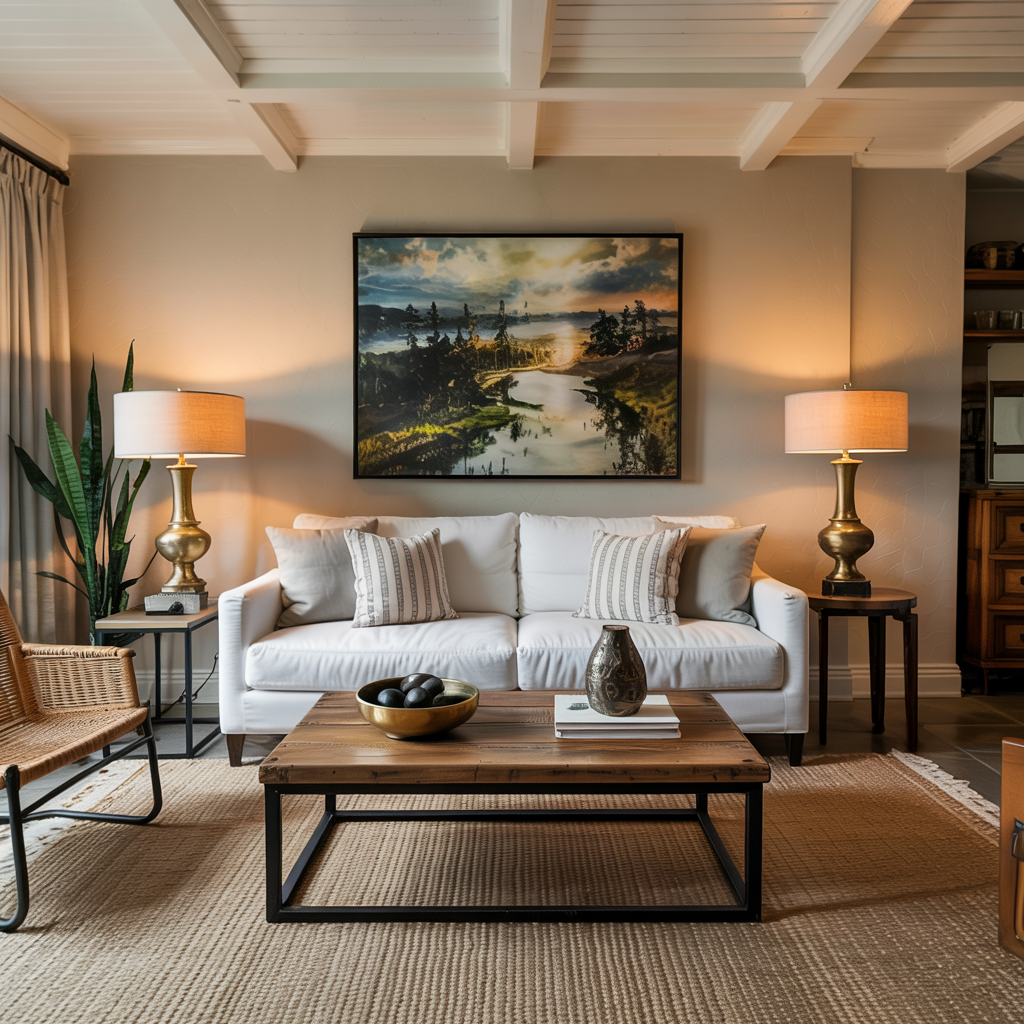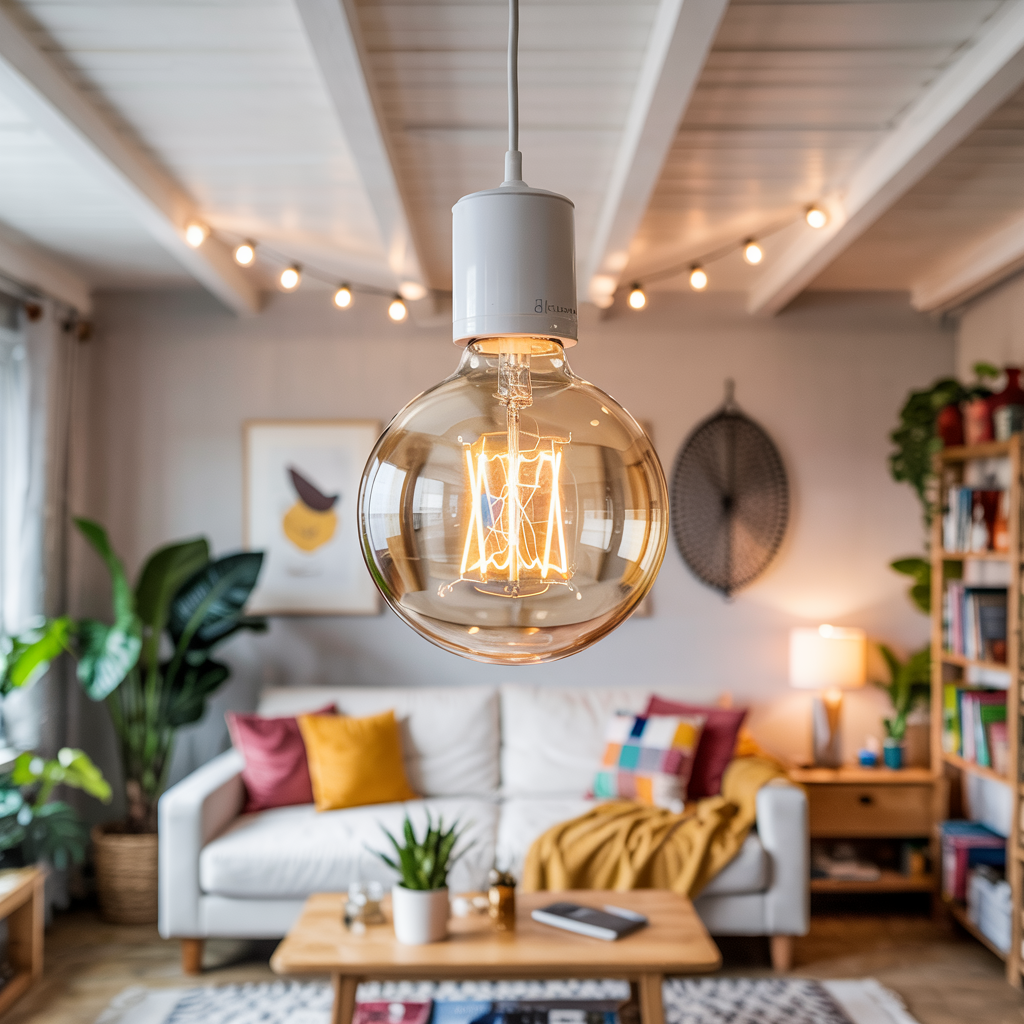How to Light a Living Room with No Overhead Lighting? A Complete Guide
Designing a beautiful and functional living room often involves overcoming challenges. One such challenge is creating a welcoming atmosphere without relying on traditional overhead lighting. This guide will explore how to light a living room with no overhead lighting, offering various solutions and strategies to illuminate your space effectively and stylishly. We’ll discuss different lighting…
Designing a beautiful and functional living room often involves overcoming challenges. One such challenge is creating a welcoming atmosphere without relying on traditional overhead lighting. This guide will explore how to light a living room with no overhead lighting, offering various solutions and strategies to illuminate your space effectively and stylishly. We’ll discuss different lighting types, placement techniques, and design considerations to help you achieve the perfect ambiance, regardless of your existing setup. You’ll learn about ambient, task, and accent lighting, and how to combine them to create a truly personalized and well-lit living space.
Many older homes or modern architectural designs lack overhead fixtures. This can present challenges in evenly distributing light, especially in larger rooms. Without careful planning, you risk creating dark corners and uneven illumination, negatively impacting the room’s atmosphere and functionality.
How to Light a Living Room with no Overhead Lighting?

To light a living room with no overhead lighting, layer multiple light sources to create balanced illumination. Start with floor lamps and table lamps to provide ambient lighting around seating areas. Add wall sconces or plug-in pendant lights for vertical lighting and to brighten dark corners. Use LED strip lights on shelves, behind TVs, or under furniture for accent lighting. Finally, incorporate task lighting like reading lamps near sofas or armchairs. Choose bulbs with warm color temperatures (2700K–3000K) and use dimmers or smart bulbs for adjustable brightness and mood control.
The key to successfully lighting a living room without overhead fixtures is to utilize layered lighting. This approach combines various lighting types to create a balanced and versatile illumination scheme. Layered lighting comprises three main categories: ambient, task, and accent lighting.
Read More: Home Theater LED Lighting Ideas: 12 Bright Ways to Elevate Your Space
Ambient Lighting: Setting the Mood
Ambient lighting provides overall illumination for the room, acting as the foundation for your lighting design. Think of it as the general light that allows you to navigate and see the overall space. Effective ambient lighting options for a living room without overhead lighting include:
- Recessed lighting installed in walls or ceiling edges (if structurally possible).
- Floor lamps strategically positioned to provide wide-area illumination.
- Table lamps with diffusing shades to softly light a central area.
- Chandeliers or pendant lights (if architectural features allow hanging from a high point).
Task Lighting: Illuminating Specific Areas
Task lighting focuses on specific areas where activities take place, ensuring adequate brightness for reading, working, or other focused tasks. In a living room, this might include:
- Desk lamps for reading or working in a designated area.
- Swing-arm lamps attached to a sofa for convenient reading light.
- Under-cabinet lighting in media centers or entertainment units.
- Floor lamps with adjustable arms to target specific areas.
Accent Lighting: Showcasing Architectural Details and Decor
Accent lighting is used to highlight specific features, art pieces, or architectural details. This adds depth and visual interest to the living room. Options include:
- Track lighting to emphasize artwork or sculptures.
- Picture lights above paintings or photographs.
- LED strip lighting installed under shelves or along the edges of furniture to create a dramatic effect.
- Uplighting to illuminate plants or tall architectural features.
Choosing the Right Bulbs: Color Temperature and Brightness

The choice of light bulb significantly impacts the mood and functionality of your lighting scheme. Consider these factors:
- Color Temperature (Kelvin): Lower Kelvin values (2700K-3000K) produce warmer, more inviting light, ideal for relaxation. Higher Kelvin values (5000K-6500K) are cooler and brighter, better suited for task lighting.
- Brightness (Lumens): Lumens indicate the brightness of a bulb. Higher lumens mean brighter light. Choose appropriate lumens based on the size of the room and the type of lighting.
- Bulb Type: Consider LED bulbs for their energy efficiency and long lifespan. Incandescent bulbs provide a warmer glow but are less energy-efficient.
Read More: Perfecting Your Living Room: Where to Place Recessed Lighting in Living Room?
Dimmers: Controlling the Ambiance
Dimmers offer unparalleled control over your living room’s lighting. They allow you to adjust the brightness of your lamps and fixtures, enabling you to create different moods, from bright and energetic to soft and relaxing. Investing in dimmers is highly recommended for a truly versatile lighting system.
Placement and Arrangement: Maximizing Light Diffusion
The strategic placement of light sources is crucial. Avoid placing lamps directly behind seating areas, as this can create glare. Instead, position lamps to illuminate the space indirectly, bouncing light off walls and ceilings to create a softer, more diffused glow. Experiment with different placements to find what works best for your room.
Mirrors: Enhancing Light Reflection
Mirrors can be effective tools in amplifying light. Strategically placed mirrors can reflect light from your lamps and fixtures, brightening darker corners and enhancing the overall illumination of the room. Consider placing a large mirror opposite a window or light source to maximize this effect.
Utilizing Natural Light: Maximizing Daylight
Maximize natural light by keeping windows unobstructed. Choose sheer curtains or blinds that allow ample daylight to enter while maintaining privacy. Natural light is an excellent source of ambient lighting, reducing your reliance on artificial light during the day.
Working with Different Room Sizes and Layouts
The best lighting solutions will vary depending on your living room’s size and layout. A small, open-plan living room might require fewer, more strategically placed lights. A larger room with separate zones might benefit from a more extensive layered lighting system. Carefully consider the size and shape of your room when choosing and positioning lights.
Budget Considerations: Balancing Quality and Affordability
Lighting solutions can range from affordable to high-end. It’s important to balance quality and affordability. Consider prioritizing key areas with higher-quality lighting fixtures and opting for more affordable solutions in less prominent areas. LED bulbs are a cost-effective choice in the long run due to their energy efficiency and longevity.
DIY Lighting Projects: Adding a Personal Touch
Many simple and effective lighting solutions can be created with DIY projects. From repurposing jars into pendant lights to creating unique lampshades, DIY lighting offers a unique and personalized approach. Numerous online tutorials and guides offer inspiration and guidance.
Professional Installation: When to Seek Expert Help
While many lighting solutions can be installed independently, complex installations (like recessed lighting or intricate wiring) should be left to professionals to ensure safety and proper functionality. Consult a licensed electrician for any complex projects.
Comparing Lighting Styles: Modern vs. Traditional
Different lighting styles suit various interior design aesthetics. Modern designs often feature minimalist, sleek fixtures and bold geometric shapes. Traditional styles incorporate ornate chandeliers, table lamps with elaborate bases, and warm-toned lighting.
Smart Lighting Systems: Automation and Control
Smart lighting systems offer convenient control over your living room’s illumination. These systems often integrate with smart home assistants like Alexa or Google Home, allowing you to control your lights via voice commands or a smartphone app. They offer features such as scheduling, dimming, and color temperature adjustments.
Troubleshooting Common Lighting Issues
Occasionally, you might encounter issues with your lighting system. Common problems include flickering lights, inadequate brightness, or uneven illumination. Troubleshooting often involves checking bulb connections, ensuring proper wiring, or adjusting light placement. If you cannot resolve the issue, consult an electrician.
Frequently Asked Questions
What are the best types of bulbs for a living room with no overhead lighting?
LED bulbs are generally recommended for their energy efficiency and longevity. Choose warm white (2700K-3000K) for ambient and accent lighting to create a cozy atmosphere, and cool white (5000K-6500K) for task lighting where brighter light is needed. Consider dimmable LEDs for greater control.
How many light sources do I need in my living room?
The number of light sources depends on the room’s size and layout. A layered lighting approach is crucial, combining ambient, task, and accent lighting. A good rule of thumb is to have at least one ambient light source, one or more task lights, and several accent lights, depending on the room’s size and decor.
How do I avoid harsh shadows in my living room?
Diffuse lighting is key to avoiding harsh shadows. Use lamps with shades or diffusers to soften the light, and bounce light off walls and ceilings to create a softer glow. Multiple light sources strategically placed throughout the room will also contribute to more even illumination.
Can I use only floor lamps to light my living room?
While it’s possible, relying solely on floor lamps might not provide sufficient or even lighting. Floor lamps excel as ambient and task lights, but combining them with table lamps or other light sources creates a more balanced and functional lighting scheme.
What is the best way to highlight artwork in my living room?
Picture lights specifically designed for artwork illumination are ideal. Alternatively, track lighting can be used to focus light on multiple pieces. Ensure the light is directed towards the artwork, not into the viewer’s eyes.
Final Thoughts
Designing a well-lit living room without overhead lighting requires careful planning and consideration of various lighting types. By thoughtfully integrating ambient, task, and accent lighting, you can create a space that is both functional and aesthetically pleasing. Remember to consider factors like bulb types, dimmer switches, and light placement to optimize your lighting scheme. Whether you opt for a modern or traditional approach, a layered system will create a welcoming and versatile atmosphere. Don’t hesitate to experiment with different light sources and placements to achieve the perfect balance for your unique living room. With a little planning and creativity, you can transform your overhead-less living room into a beautifully illuminated sanctuary.

